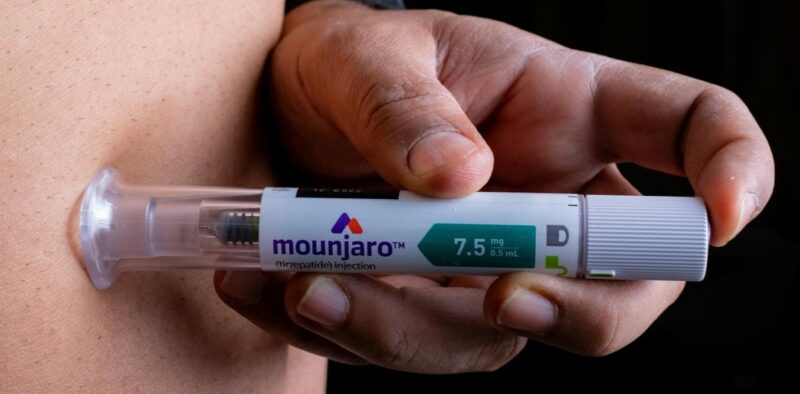Diabetes
Mounjaro Injection: Transforming Healthcare as We Know It
What Is Mounjaro?
Mounjaro is an antidiabetic drug that is utilized mainly for the management of blood glucose levels in adults with type 2 diabetes. It contains the active ingredient tripeptide, which mimics the effects of GIP and GLP-1, which are two hormones in the body of human beingsbeing.
Both hormones control blood sugar levels by promoting insulin production and inhibiting the release of glucagon, a hormone that increases blood sugar levels.
Besides blood sugar regulation, Mounjaro has recently received FDA approval for weight loss in people with obesity or those who are overweight and have at least one comorbidity related to weight.
This approval is based on the outcomes of research studies and clinical trials showing that Mounjaro is effective in weight loss.
Mounjaro is a new type of medication that can help patients with Type 2 diabetes lose weight and maintain better control of their blood sugar levels.
Mounjaro’s Effect On Type 2 Diabetes and Obesity
Can Mounjaro help people with Type 2 diabetes and obesity? Indeed! It helps in managing type 2 diabetes well.
Managing Blood Sugar Levels
How does Mounjaro injection control blood sugar levels? It has dual GLP-1/GIP receptor agonist properties. That helps it increase insulin sensitivity. Plus, it can manage glucose production more efficiently. It aims to regulate your blood glucose levels.
Aiding Weight Loss in Patients with Diabetes
Does losing weight seem impossible if you have type 2 diabetes? Mounjaro can come to your rescue! It helps to keep you satisfied. It even reduces your sugar cravings.
You can finally get rid of those extra pounds! But this is just an add-on effect. Mounjaro has not been approved as a weight loss drug.
Right before the following table, we can confidently say that Mounjaro checks all the right boxes.
Mounjaro To Lose Weight.
mounjaro injection for weight loss that works by reducing appetite. It achieves this by influencing two hormones:
- GIP (glucose-dependent insulinotropic polypeptide): This hormone is released after eating and helps regulate blood sugar levels. Mounjaro stimulates the production of GIP, which leads to an increased feeling of fullness.
- GLP-1 (glucagon-like peptide-1): This hormone is released after eating and helps regulate blood sugar levels. Mounjaro acts as a GLP-1 receptor agonist, meaning it imitates the function of GLP-1. This results in an increased feeling of fullness and a reduced appetite.
Mounjaro has been proven effective in aiding weight loss for overweight or obese individuals. In clinical studies, participants who took Mounjaro experienced an average body weight reduction of 12.4%. This effect surpasses other weight loss medications like Saxenda (liraglutide).
Before starting Mounjaro, you must discuss potential side effects with your healthcare provider.
Where To Inject Mounjaro ?
Mounjaro is given as a subcutaneous (under the skin) injection. Your healthcare professional can help you choose the best site for the injection. You or someone else can give the injection in one of these areas:
Abdomen:
The abdomen is often recommended because it has a large surface area and is easy to reach. The layer of fat just below the skin in this area helps the body absorb Mounjaro effectively. When giving the injection in the abdomen, pick a spot about two inches away from the belly button.
Thigh:
The front of the thigh is also a good option for injections because there is enough fat for subcutaneous injections. Avoid injecting in the inner thigh.
Upper arm:
The back of the upper arm is another choice, especially for those who prefer injecting in a less visible area. When giving injections in the upper arm, choose a spot between the elbow and shoulder. If you decide to use this site, have someone else give you the injection.
How Does Mounjaro Work?
Mounjaro Injection 5 Mg contains the active ingredient tripeptide, which imitates your body’s GLP-1 and GIP hormones. By imitating the GIP hormone, it sends signals through the brain to regulate energy balance.
In addition, by mimicking the GLP-1 hormone, tripeptide slows digestion, reduces hunger, and combats cravings. The combination of these effects makes the dual-acting medication a reliable treatment for reducing appetite, ultimately leading to weight loss.
It’s important to note that Mounjaro alone isn’t a suitable treatment for obesity nor a replacement for a healthy lifestyle. It should always be used together with a balanced diet and regular exercise.
Who Is A Good Candidate For Mounjaro?
Mounjaro is specifically intended for adults with type 2 diabetes who are struggling with Weight loss. This weight loss drug is designed for individuals with a body mass index (BMI) of 27 or greater who have at least one weight-related condition, such as high blood pressure, high cholesterol, or sleep apnea.
It is important to note that Mounjaro is not a magic pill for weight loss and should only be used as part of a comprehensive weight loss plan that includes healthy eating and exercise.
Individuals considering Mounjaro should discuss their weight loss goals with their healthcare provider to determine if Mounjaro is right for them.
How To Use Mounjaro Injection?
Read the Medication Guide and Instructions For Use provided by your pharmacist before you start using tripeptide each time you get a refill. Learn all preparation and usage instructions. If you have any questions, ask your doctor or pharmacist.
Before using:
- Check this product visually for particles or discoloration.
- If either is present, do not use the liquid.
- Before injecting each dose, clean the injection site with rubbing alcohol.
Change the best mounjaro injection site each week to lessen injury under the skin. Inject this medication under the skin in the thigh, abdomen, or upper arm as directed by your doctor, usually once every seven days.
The dosage is based on your medical condition and response to treatment. To reduce your risk of side effects, your doctor may direct you to start this medication at a low dose and gradually increase your dose. Follow your doctor’s instructions carefully.
This medication may be used with or without meals. Use this medication regularly to get the most benefit from it. Remember to use it every seven days. It may help to mark your calendar with a reminder.
If needed, the day of weekly use may be changed as long as the time between two doses is at least three days. Carefully follow the medication treatment plan, meal plan, and exercise program your doctor has recommended.
What Are Mounjaro’s Potential Risks And Adverse Effects?
Like all medications, the mounjaro injection site has some common side effects. Most of these are mild, including nausea, diarrhea, vomiting, and Constipation.
In rare cases, Mounjaro can cause inflammation of the pancreas (acute pancreatitis), which may result in severe abdominal pain or kidney damage. If you experience any of these side effects, contacting your healthcare provider immediately is crucial.
It’s also essential for individuals considering Mounjaro to know about the potential for low blood sugar (hypoglycemia) when using this diabetes medication.
This is more likely to happen if you’re taking it with other blood sugar-lowering drugs like insulin or sulfonylureas or if you need to eat more. Signs of low blood sugar can include shakiness, confusion, and sweating.
Make sure to regularly check your blood sugar levels and carry a source of sugar with you in case of a hypoglycemic episode.
Some people may have an allergic reaction to Mounjaro. Symptoms of an allergic reaction can include a rash, itching, swelling, and difficulty breathing. If you experience these symptoms after taking Mounjaro, seek medical attention immediately.
FQAS :
What is Mounjaro injection?
Mounjaro injection is a medication used to manage type 2 diabetes by controlling blood sugar levels. It is administered subcutaneously.
How does Mounjaro injection work?
Mounjaro injection helps regulate blood sugar levels by stimulating insulin release and reducing glucose production in the liver.
How is the Mounjaro injection administered?
Mounjaro injection is given subcutaneously, usually in the abdomen, thigh, or upper arm, as directed by a healthcare professional.
What are the common side effects of Mounjaro injection?
Common side effects include nausea, diarrhea, headache, and injection site reactions. Consult your doctor if side effects persist.
Who should not use Mounjaro injection?
Individuals with a history of severe allergic reactions to Mounjaro or its components should avoid its use. Consult your doctor for alternatives.
Can Mounjaro injection be used with other diabetes medications?
Yes, Mounjaro can be used with other diabetes medications, but consult your doctor for personalized treatment plans and to avoid interactions.
How to administer Mounjaro injection?
Administer Mounjaro injection subcutaneously in the abdomen, thigh, or upper arm once weekly. Follow your healthcare provider’s instructions for proper technique.
Does Mounjaro injection hurt?
Mounjaro injection may cause mild discomfort or pain at the injection site. Consult your doctor if the pain persists or worsens.
What are the side effects of Mounjaro injection?
Common Mounjaro injection side effects include nausea, diarrhea, headache, and injection site reactions. Consult your doctor if side effects persist.
What are the Mounjaro injection instructions?
Administer Mounjaro injection subcutaneously in the abdomen, thigh, or upper arm weekly. Follow your healthcare provider’s instructions precisely.






This breakthrough could indeed transform healthcare! I’d love to hear more about the patient experiences you mentioned.